Film & Television
The visual arts, storytelling, drama—for many Sarah Lawrence students, these combine in a passion for the art of cinema. Courses in the history, aesthetics, and rhetoric of film build on strong backgrounds in the liberal arts, producing students with broad cultural awareness, refined critical judgment, and highly developed creative ability—ideal for careers in the film industry, where they work as independent filmmakers, producers, directors, screenwriters, and casting agents.
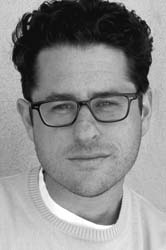 J.J. Abrams ’88
J.J. Abrams ’88
(creator, executive producer, screenwriter, director)
In his final year at Sarah Lawrence, J.J. Abrams collaborated with a friend to write a feature film treatment, which became 1990’s Taking Care of Business. Since then, he has written such films as Regarding Henry, Forever Young, Armageddon, and Joy Ride; and served as co-creator and executive producer of the TV series Felicity and creator and executive producer of the series Alias and Lost. For the former series, Abrams also co-wrote the theme song; for the latter, he composed theme music. He has directed episodes of both. He also co-created, produced, and wrote for the science fiction series, Fringe.
Abrams wrote and directed Mission: Impossible III, produced and directed Star Trek and its sequel Star Trek Into Darkness, and, most recently, wrote, produced, and directed Star Wars: The Force Awakens.
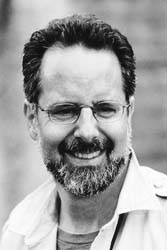 Jon Avnet ’71
Jon Avnet ’71
(film director and producer)
Jon Avnet says Sarah Lawrence helped him hone the most important skill for anyone trying to create high-quality work in film: original thinking. “It’s the ability to process lots of input and come up with a decision, as opposed to simply knowing how others have done it. What interested me was doing things in ways no one had ever done before. The fit between me and Sarah Lawrence was natural.”
“At Sarah Lawrence, instead of learning to distrust your impulses, you were told, see where they go, where they lead,” Avnet says. His passion for performance led him, while he was a student, to the La Mama theatre company in New York City. “I did everything from hanging lights to directing stuff that had been written by other Sarah Lawrence students.” Avnet’s credits include Risky Business, The Burning Bed, Fried Green Tomatoes, Righteous Kill—a 2008 film starring Robert De Niro and Al Pacino—and the critically acclaimed television series Boomtown. He also produced Sky Captain and the World of Tomorrow, and the award winning Broadway productions Spamalot and Pillowman, nominated for a combined 20 Tony’s. The Sarah Lawrence education calls for high initiative, Avnet says. “But if you’re a self-starter and willing to accept the challenge of uncertainty, which is pretty daunting, it’s a great place.”
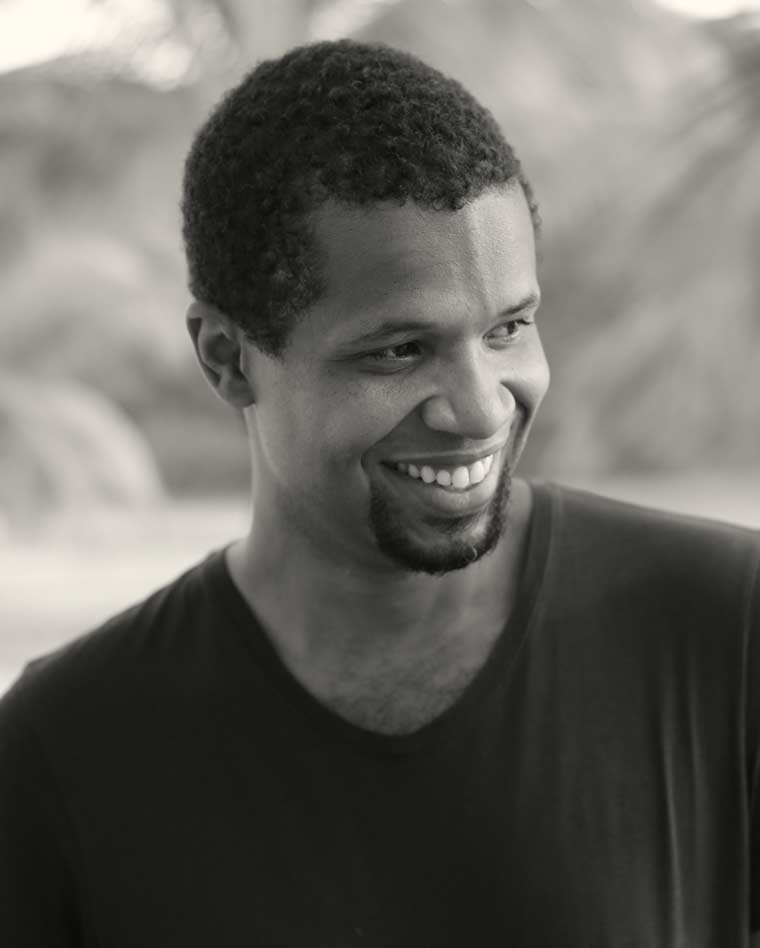 Damani Baker ’96
Damani Baker ’96
(documentary filmmaker, director: Still Bill and The House on Coco Road)
Damani Baker's over 20-year career as a filmmaker includes work that spans museum installation, feature documentaries and advertising. Most recently in The House on Coco Road (acquired by Ava Duvernay’s ARRAY RESELASING), Baker combined family super-8 with, archival news and family interviews to weave his mother's personal story with broader historical threads to tell a story of migration and the Grenada Revolution. The House on Coco Road and his first feature Still Bill, on the life and music of Bill Withers, have been critically acclaimed and featured in the New York Times, The New Yorker, Los Angeles Times, Time Out and the Village Voice among others. Both Still Bill and The House on Coco Road enjoy worldwide distribution on Showtime, Netflix, and BBC.
His perspective has gained the attention of clients such as Apple, Ralph Appelbaum Associates (RAA), Wieden+Kennedy, Rainforest Alliance, IBM and the UN. With RAA, Baker has directed over 20 films for museums around the world featuring such notables as President Bill Clinton, Kofi Annan and President Ellen Johnson Sirleaf, all stories rooted in understanding the human story as it's connection to place. He’s recently returned from Iceland where he directed “Waterfalls”, a music video for Meshell Ndegeocello. Produced by his production arm Station 10, Baker collaborated with students in the United Nations University Program on Gender Equality to deliver this groundbreaking work.
Baker's work has been supported by Sundance Institute, Ford Foundation, the George Soros Foundation and he is an alum of Filmmaker Magazine's 25 to watch. Baker is also a tenured professor at Sarah Lawrence College where he teaches filmmaking to a diverse group of creatives, ensuring the stories from all of our communities continue to be told with grace, dignity, and power.
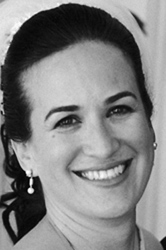 Debra Zane ’83
Debra Zane ’83
(casting director)
“I knew a large university wasn’t for me,” says Debra Zane, “so even going to Sarah Lawrence was following my heart. I just continued to follow it.” To Zane, “following it” meant doing what felt right—and eventually ending up as a leading Hollywood casting director. “People should be patient with themselves,” she says. “I didn’t know what I was doing for six years after graduation, but I did know enough about myself to move on from smaller jobs.”
In the late 1980s, Zane moved from Manhattan to California. There she discovered an interest in casting while working on a film with fellow Sarah Lawrence alum Jon Avnet. By the mid-90s, she had founded her own company, Debra Zane Casting, through which she has helped create such popular and critically acclaimed films as Wag the Dog (1997), American Beauty (1999), Traffic (2000), Ocean’s Eleven (2001), Catch Me If You Can (2002), and Dreamgirls (2006). She credits Sarah Lawrence with preparing her for the opinion-driven crossfire of film production meetings. “Because it was a nice small place, the teachers made you feel like you had something to say. And you had to be accountable. It made me feel that what I have to say is worth listening to.”
Nicole Betancourt ’90
Emmy award-winning filmmaker: 90 Miles (PBS), winner, Best Documentary at the New York Latino International Film Festival
Donna Gigliotti ’76
producer: Vanity Fair, Shakespeare in Love, Emma, The Reader
Darnell Martin ’86
screenwriter, director: Cadillac Records, I Like It Like That, Prison Song; actor: Nowhere Fast, Deadly Obsession
Anika Poitier ’94
director, actress, writer: The Devil Cats
Peter Schnall ’75
director, producer: Air Force One, The Brotherhood of 9/11, Diamonds
Helen C. Whitney ’65
Emmy Award-winning documentary filmmaker: Richard Avedon: Darkness and Light, Faith and Doubt at Ground Zero; winner, Writers Guild of America Award for Documentary, among others
Heather Winters ’84
Film producer, director, and writer. Two-time Sundance winning executive producer. Credits include: Oscar-nominated Super Size Me; TWO: The Story of Roman & Nyro; The Rest I Make Up (Best Movies of 2018, The New Yorker), Anywhere, u.s.a.; Class Act; Convention; Google Me; ThunderCats; Silverhawks; The Comic Strip; MTV’s Real World. Sarah Lawrence Filmmaking & Moving Image Arts faculty, 2011-
Performing Arts
The performing arts at Sarah Lawrence integrate theoretical study and practical experience in the context of a liberal arts education. Students develop perspective, interpretive skills, and knowledge to augment their work in the performing arts. Sarah Lawrence’s proximity to New York City draws world-class practitioners as faculty and allows students to observe and participate in the professional world prior to graduation.
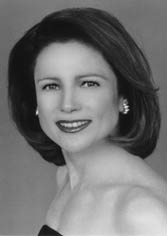 Tovah Feldshuh
Tovah Feldshuh
(actress: Broadway, television, and film)
You may know Tovah Feldshuh as Israel’s fourth Prime Minister, Golda Meir, in Golda’s Balcony, the hit Broadway play that earned the actress her fourth Drama Desk Award, her first Lucille Lortel, and her fourth Tony nomination. Or you may remember her as Helena in the miniseries Holocaust or Danielle Melnick on Law & Order—both of which earned her Emmy nominations—or for roles in the 2006 films Lady in the Water and Just My Luck. In her 30-plus-year Broadway, television, and film career, she finds that the heart of her accomplishments is the pathway, not the prizes. “In college, I learned that it’s the process that’s invaluable. Sarah Lawrence made my education very process-oriented, not only results-oriented. Results inevitably reflect the journey taken.” At Sarah Lawrence , where she focused on philosophy, Feldshuh learned not only how to perform the play, “but how the play is built, explored, investigated. Most importantly—how one can try, fail, and try again. We could dare.”
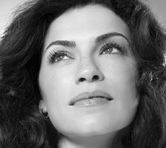 Julianna Margulies ’89
Julianna Margulies ’89
(actress: The Good Wife, ER, Paradise Road, The Mists of Avalon, Canterbury’s Law, The Sopranos, City Island)
“My experience at Sarah Lawrence gave me a great sense of self, and it gave me such confidence in being an independent thinker,” she says. “Whether it was through theatre studies, English lit, art history, or the history of film, I left with a deeper knowledge of who I was, because I was allowed to fully explore these subjects and inspired to think for myself.”
Acclaimed actress and alumna Julianna Margulies is widely respected for the integrity of her work in film, television, and theatre. Getting her start in student productions at Sarah Lawrence, Margulies won best actress Golden Globe and Screen Actors Guild awards in 2010 for her leading role in the CBS series The Good Wife. This SAG award is her seventh. Also in 2010, Margulies starred opposite Andy Garcia in the dramatic comedy, City Island. Co-starring Alan Arkin and Emily Mortimer, the film won the 2009 Audience Award at the prestigious Tribeca Film Festival. Her feature credits also include Evelyn with Pierce Brosnan and Paradise Road with Glenn Close.
As one of the original cast members of the renowned NBC television series ER, Margulies earned both an Emmy Award and a SAG Award for her role as nurse Carole Hathaway. Other TV projects have included The Mists of Avalon miniseries, The Sopranos, and The Grid, for which she received Golden Globe nominations.
On stage, Julianna Margulies received a Lucille Lortel Award for her work opposite Donald Sutherland in Robin Baitz’s Ten Unknowns at Lincoln Center, and she went on to make her Broadway debut in Festen. Additional theatre performances have included The Vagina Monologues and Kate Robin’s Intrigue with Faye, among numerous others.
Watch Julianna Margulies' 2010 Commencement address
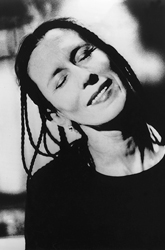 Meredith Monk ’64
Meredith Monk ’64
(performance artist, composer, singer, director/choreographer, and performer)
Meredith Monk refuses to be categorized. Besides being a “genius” (she won the prestigious MacArthur “Genius Grant” in 1995), Monk is a singer, filmmaker, artist, composer, performer, director, and choreographer. In 1968, Monk founded The House, a company dedicated to an interdisciplinary approach to performance. In 1978, she expanded the musical territory of voice with Meredith Monk and Vocal Ensemble. Monk has also pioneered site-specific performance, creating such works as “American Archaeology #1: Roosevelt Island,” among others. Her work has been featured in a retrospective art exhibition, Meredith Monk: Archaeology of an Artist, at the New York Public Library for the Performing Arts at Lincoln Center. “A Sarah Lawrence education teaches you that you are in charge of yourself, that learning is a lifetime occupation, and that you have the right and duty to be what some people would call a ‘troublemaker’—that is, an independent, intelligent, curious person who wants to find his or her own solutions to things.”
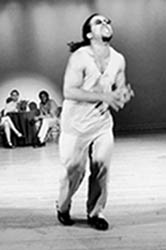 Jimmy Tate ’91
Jimmy Tate ’91
(professional dancer, singer/songwriter, performer)
Sarah Lawrence can’t take credit for teaching Jimmy Tate how to dance. When he was just 13, he played the starring role in The Tap Dance Kid on Broadway. At Sarah Lawrence, he took the opportunity to explore music—including courses in electronic music—and fiction and poetry writing. He developed a new vocation, as a folk singer and songwriter, and spent afternoons on the College lawn playing guitar with other student musicians. He also did a one-man show in the Students of Color Series on campus, and other students enlisted him to perform in their shows. Sarah Lawrence “really reawakened my love for the theatre,” he says. Tate now has two career paths. One is dance and musical theatre: he starred on Broadway in Bring in Da Noise, Bring in Da Funk, and currently teaches at the Broadway Dance Center in New York City. The other is as a folk singer/songwriter who has released his own CD, Play Me. Tate says he was especially influenced by the Sarah Lawrence environment. “To meet so many different people broadened my idea of what I wanted to do and who I wanted to be.”
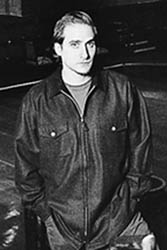 David Warren ’83
David Warren ’83
(theatre director)
“I found my voice as a director as an undergraduate, and that’s very unusual,” says David Warren. “I think it was a combination of who I am and the fact that Sarah Lawrence had one of the few undergraduate departments where you could direct a full production.” His career took off in his senior year, when he did an internship as a directing apprentice at Playwrights Horizons in New York City. “It was the moment when my education went from the theoretical to the practical in a very organized way,” he says. Warren garnered an Obie Award for Pterodactyls, and directed Matt & Ben, a 2002 Fringe Festival hit that tells the “story” of Matt Damon, Ben Affleck, and Good Will Hunting. He has worked on two Broadway productions and recently directed his first TV show, an episode of Desperate Housewives. “At Sarah Lawrence, I learned how meaning is made, which is the heart of directing.”
Jane Alexander ’61
former chairman: National Endowment for the Arts; actress and recipient, Tony, Emmy and numerous other awards; author: Command Performance: An Actress in the Theatre of Politics
Elise Bernhardt ’78
executive director: National Foundation for Jewish Culture; founder and former executive director: Dancing in the Streets
Agathe David-Weill ’95
co-founder, producer: Messenger Theatre Company, New York City; independent film producer: Dead Sexy, Talking Richard Wilson Blues
Jed Distler ’78
composer, music curator, artistic director: Composers Collaborative Inc., New York City; composer-in-residence: West Park Presbyterian Church, New York City
Beverly Emmons ’65
artistic director: Lincoln Center Institute; and Obie Award-winning lighting designer
Caroline Hall ’92
actress: Pericles, Cabaret, Threepenny Opera; musician, multi-instrumentalist, trombonist: Klezmer Klub
Daniel Hurlin ’79
Obie Award-winning performance artist; puppeteer; faculty member: Sarah Lawrence College
Nan Knighton ’69
theatrical lyricist: Saturday Night Fever, The Scarlet Pimpernel; playwright: Man with Two Hearts Found on the Moon
Joyce S. Moorman MFA ’75
composer; 11-time winner, American Society of Composers, Authors and Publishers’ Award
Holly Robinson Peete ’86
actress: 21 Jump Street, Hanging with Mr. Cooper, For Your Love
Carly Simon ’65
Award-winning singer, songwriter: “You’re So Vain,” “Anticipation”
Joanne Woodward ’90
Oscar-winning actress: The Three Faces of Eve, Mr. & Mrs. Bridges, The Age of Innocence, among many others; environmentalist
Visual Arts & Arts Management
The College offers courses taught by active, professional artists in a wide spectrum of media—drawing, painting, photography, printmaking, and sculpture—and in visual fundamentals, an introduction to converting ideas into visual structures. Students take advantage of the College’s proximity to New York City by visiting the constant variety of art on exhibit in its many museums, galleries, and studios.
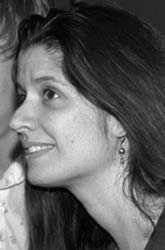 Janine Antoni ’86
Janine Antoni ’86
(performance artist; sculptor; painter; work exhibited in Atlanta, Boston, Dublin, London, New York, and Venice)
Award-winning artist Janine Antoni has exhibited at institutions including the Whitney Museum of American Art and the Guggenheim Museum in New York City. Her work blurs the distinction between performance art and sculpture; her primary tool for making sculpture is her own body. “Trusting my inclinations…was the most valuable lesson I learned at Sarah Lawrence.” How did the artist develop such a nontraditional approach to art? In many ways, the journey began at Sarah Lawrence, where Antoni studied literature, psychology, anthropology, and religion, and visited New York City museums. “What prepared me most for being an artist,” Antoni recalls, “was the ability to form a curriculum that nurtured my passions. Trusting my inclinations—and the confidence to enter into the world and explore where this inspiration might lead me—was the most valuable lesson I learned at Sarah Lawrence.”
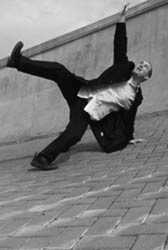 John Pilson ’91
John Pilson ’91
(video artist)
John Pilson transferred to Sarah Lawrence looking for a stronger arts program, and he found it. “It was such a relief to be able to design my own curriculum,” Pilson says. “Instead of art history, I studied the philosophy of aesthetics. It was great.” After he graduated from the MFA program in photography at Yale, Pilson became interested in video and began to use this medium to investigate the interior architecture of cities, especially office spaces. “I like to explore the ways life rushes into the corporate vacuum,” he says; one memorable work features doo-wop singers in an elevator.
Since his first video premiered at P.S. 1 Contemporary Art Center, Pilson has shown his work regularly in venues such as the Museum of Modern Art and the Hamburger Kunsthalle in Germany. At the 2002 Venice Biennale, he was awarded one of four prizes for artists in the International Exhibition. He currently teaches at Bard College and in the MFA program at Yale School of Art. “At Sarah Lawrence, I was surrounded by very talented and committed artists,” Pilson says. “I didn’t have a lot of confidence about being an artist myself, but the Sarah Lawrence community showed me how it could be done.”
Valerie Beller ’87
painter; professor: Art Institute of Chicago
Martha Fleischman ’75
president: Kennedy Galleries, New York City
Miranda McClintic ’69
art historian and critic specializing in 20th century art; former curator of exhibitions: Hirshhorn Museum and Sculpture Garden; author: Modernism and Abstraction (Watson-Guptill Publications), among others
Wesley Miller ’00
sculptor; curator and producer: Art:21: Art in the Twenty-First Century (PBS)
Linda B. Shearer ’68
past director: Contemporary Arts Center, Cincinnati; interim director: The Contemporary Arts Museum, Houston
Alec Soth ’92
photographer: Minneapolis Institute of Arts; works exhibited: Whitney Biennial, New York City; Museum of Contemporary Photography, Chicago; Yossi Milo Gallery, New York City, among others; photojournalist: New York Times Magazine, Fortune, Newsweek; winner of Jerome Fellowship, McKnight Photography Fellowship, among others
Nancy Spector ’81
curator: Guggenheim Museum, New York City
Peter Stevens ’77
artist, sculptor; executive director: estate of artist David Smith
Business
One quarter of Sarah Lawrence graduates are self-employed, and 6 percent earn MBAs, and this entrepreneurial spirit and managerial ability ties in directly to their academic experience. Here, students plan their own individualized academic programs, guided by their dons. As they create and pursue independent projects, the skills they learn in the process—planning, determining their needs, consulting with experts, and taking responsibility—are the tools necessary for success.
Peggy Woodford Forbes ’63
(chairman and CEO: Woodford Capital Management, LLC)
As chairman, CEO, and CIO of the firm she founded in 1990, Woodford Capital Management, LC, Peggy Woodford Forbes is the first African-American woman to establish a registered investment advisory firm in growth equity management in the United States. Forbes oversees the portfolio management team and the overall operations of the firm, located in Los Altos, California. She frequently contributes her investment insights to financial magazines and news shows. At Sarah Lawrence, she studied comparative literature. Big jump? Not so, she says. “At Sarah Lawrence, you have to stretch a lot, think a lot, and develop new ideas and strategies.”
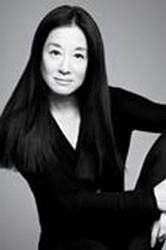 Vera Wang ’71
Vera Wang ’71
(fashion designer and owner: Vera Wang Bridal House, Vera Wang brand fragrances, jewelry, shoes, and houseware collections)
Vera Wang entered Sarah Lawrence as a pre-med student, with a career as a championship figure skater already on her résumé. Before going on after graduation to become a renowned fashion designer, she studied theatre and art history. What allowed her to change course and prepared her to become one of the top figures in today’s fashion world? The answer is less about which courses she took than about what most students at Sarah Lawrence really focus on: creativity.
After graduation, Wang became an editor at Vogue, and later a design director for Ralph Lauren. Then, after a frustrating search for the perfect wedding dress, she did what any self-respecting Sarah Lawrence graduate would do: she designed her own. What followed was her trademark line of wedding dresses for contemporary women like herself who defy stereotypes. She has also created gowns for celebrities like Uma Thurman and Jennifer Lopez. Wang once said, “To redefine the color white is infinitely challenging.” And while she didn’t learn specifically how to redefine the color during her four years at the College, she learned to believe that she could.
Norma Jean Darden ’61
business owner, restaurateur, author
Carl Goldfischer ’80
managing director: Bay City Capital
Eric Hermann ’74
president, portfolio manager: FH International, African investment banking firm; Fulbright Grant recipient
Gloria Lau ’76
former president: Charles Schwab Asia, Tokyo
David Netto ’92
furniture designer and founder: David Netto Design
Mason Stark ’93
director in equity department, managing member: Ramius Capital Group, LLC
Hilary Beall Tesoriero ’85
global strategic sales, The Bank of New York Mellon
Government & Public Service
Just as they shaped their own destiny at Sarah Lawrence, many of the College’s graduates work toward shaping the destiny of others through the institutions that govern and improve the world.
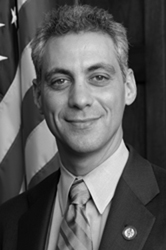 Rahm Emanuel ’81
Rahm Emanuel ’81
(congressman from Illinois: US House of Representatives; chair, Democratic Caucus; chair, 2006 Democratic Congressional Campaign Committee; former senior advisor to the President; former White House Chief of Staff for President Barack Obama; currently Mayor of Chicago)
“The four years I spent at Sarah Lawrence College taught me that with hard work and dedication, anything can be accomplished,” Emanuel says. After graduating from Sarah Lawrence, Rahm Emanuel worked for a public interest group, became an adviser with the Democratic Congressional Campaign Committee, and co-founded a political consulting firm. Joining the Clinton presidential campaign team in 1991, Emanuel demonstrated the tenacity and drive that would characterize his years at the White House: as financial director for the campaign, he raised a record $70 million in funds. He then planned Clinton’s inauguration, continuing on to serve as the political director and senior adviser to the President at the White House.
As a member of Congress, he continued to champion causes he considered vital to the public welfare, including such efforts as his "American Parity Act," a bill that seeks to balance America's investments in housing, education, health care, and other domestic priorities with equal spending in the Iraq post-war reconstruction plan. From 2008 until 2010, Emanuel served as President Barack Obama’s White House chief of staff. In 2011, he took office as the 46th Mayor of Chicago.
Watch Rahm Emanuel's 2009 Commencement address: Part 1 Part 2
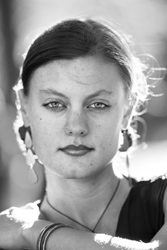 Molly Delano ’98
Molly Delano ’98
(co-founder: La Abeja Obrera; associate program director: Global Kids)
Molly Delano’s background is steeped in lessons about social justice. Born in West Virginia, where her parents were organizers for the United Mine Workers of America, she grew up in Harlem. “My parents raised me to know that political action is very important,” she says, “and to think internationally.” At Sarah Lawrence she took sociology and labor history classes, which “allowed me to make connections between the personal and the political.” Delano has spent her career in the field of progressive work: advocating for destitute and homeless New Yorkers, training high school students to be community leaders and activists and, most recently, imparting life and coping skills to ease the way for young people just out of prison. She is also a co-founder and active participant in La Abeja Obrera, a group that does community service projects in Cuba and studies the intricacies of Cuban-American relations. “Education,” she says, “is a key that opens the door to civic involvement.”
Brooke Anderson ’86
deputy assistant to the President and chief of staff and counselor for the National Security Staff: White House; former US ambassador: United Nations; former vice president of communications: Nuclear Threat Initiative; former co-director: Nuclear Security Project
Lauren Fishbein ’82
trial attorney: Attorney General’s Honor Program, US Department of Justice; 2004 US Attorney General’s John Marshall Award Recipient
Alice C. Greenwald ’73
director: World Trade Center Memorial Foundation; former associate director for museum programs for the United States Holocaust Memorial Museum in Washington, DC
Saudia Lawrence ’89
co-director: Multicultural Alliance, San Francisco; model
Daniel R. Russel ’75
deputy chief of mission: US Embassy, Netherlands
Michael Sartisky ’73
president, executive director: Louisiana Endowment for the Humanities, New Orleans
Law
A Sarah Lawrence graduate arguing a complex or obscure case in court might flash back to a conference or seminar at the College. Here, students are steered away from simply accepting opinions or information handed down in books or from classmates and teachers. They learn that once they become well versed in the topic at hand, they should argue cogently for their interpretation of it. This training propels many Sarah Lawrence graduates on to the nation’s top law schools.
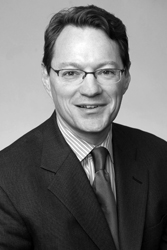 Mark P. Goodman ’83
Mark P. Goodman ’83
(partner: Debevoise & Plimpton, New York City)
Before he came to Sarah Lawrence, Mark P. Goodman thought of law as dry and not particularly interesting. But during his second semester, a constitutional law course changed his mind. “I realized during that semester the extent to which the law pulled together strands of the other subjects I was studying, including history, sociology, philosophy, and even an element of theatre,” Goodman says. “It was also combative, which I liked.” Since he graduated from the New York University School of Law, Goodman has worked at a major Manhattan firm where he participated in high profile cases such as those involving flag burning and the death penalty argued before the United States Supreme Court, and business disputes over billion dollar mergers and acquisitions. He has also served as an Assistant U.S. Attorney in New York City.
 Joy Vida Jones ’71
Joy Vida Jones ’71
(attorney)
In her first year at the College, Joy Vida Jones intended to prepare for medical school, but by graduation she found herself prepared for almost anything. “At Sarah Lawrence, I learned how to learn,” she says. “That’s more important than what you learn.” She chose law school. A pivotal course for Jones was “American Institutions,” taught by Gerda Lerner, who later established the women’s history program at Sarah Lawrence. “She taught us to do research at the graduate level using primary sources. I didn’t realize how much I was learning at the time, but it was the most helpful thing once I got to law school.”
“The ongoing nature of conference work at Sarah Lawrence gave me realistic expectations with respect to the work world, which is also an ongoing process,” she says. Through that process, Jones became a partner at Rogers & Wells (now Clifford Chance), one of the world’s largest law firms. Before law school, Jones worked for Black Enterprise magazine as director of public affairs and at the African American Institute as program officer, bringing African professionals to the United States to meet their counterparts. For four years in the early 90s, she took a break from her law career to pursue a business venture: managing jazz musicians. Now she’s back in the law as a corporate attorney specializing in finance and real property. She currently serves on the Board of Directors for Twenty-First Century Foundation, a national grant-making body for Black community initiatives and youth development.
Jon Avins ’86
operations analyst: The World Bank; lawyer specializing in general commercial litigation
Stephanie R. Cooper ’65
MFA ’76, president: Law Offices of Stephanie R. Cooper, PC, New York City; winner, Belkin Scholarship, Alexander Fellowship
Elizabeth Kennedy ’60
attorney, mediator: Elizabeth Kennedy Office, Anchorage
Kay Harris Patterson ’89
intellectual property counsel: SRA International, Inc., Fairfax, VA
Medicine & Science
Sarah Lawrence excels in training students for advanced work in medicine, psychology, and science. The College not only sends students to top graduate and medical schools, but also teaches the natural sciences and mathematics in a rigorous way that reveals to students—regardless of their career plans—the creative, elegant intellectual process inherent in formulating and testing hypotheses.
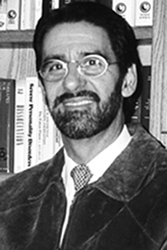 Roberto Flores de Apodaca ’74
Roberto Flores de Apodaca ’74
(forensic psychologist and educator: Concordia University, Irvine, CA)
When Roberto Flores de Apodaca first arrived at Sarah Lawrence College more than 35 years ago, he was, in his own words, “just a little kid from New York City.” What happened during the next four years, though, taught him otherwise. He now holds a doctorate in psychology, is on the faculty of Concordia University in Irvine, California, and has a successful private practice as a forensic psychologist. “It was the unique combination of fundamentals paired with the freedom to pursue one’s individuality that made the difference,” he says. “Without that and the people at Sarah Lawrence who believed in me, I’m not sure I would have come this far.”
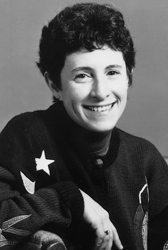 Joanne Kurtzberg ’72
Joanne Kurtzberg ’72
(physician, scientist, director: Pediatric Bone Marrow Stem Cell Transplant Program, Duke University Medical Center)
In retrospect, it seems like a perfectly natural progression from the High School of Music and Art in New York City to Sarah Lawrence and then to New York Medical College. And Joanne Kurtzberg, director of the Pediatric Bone Marrow Stem Cell Transplant Program at Duke University Medical Center—an internationally recognized program dedicated to providing outstanding care and support to pediatric patients who can be helped by transplantation therapy—says that she would do it the same way all over again. When she began her liberal arts courses at Sarah Lawrence, science and math were running a close second to her first love, music. By the time she graduated in 1972, she knew medicine and not music would be her career. But she advises even those students who are considering medicine as a career not to narrow their focus too early. “Learn how to learn and seek a wider breadth of knowledge. To be able to recite a list of chemicals is not important to me. That’s not learning. Learn how to solve problems, how to figure things out on your own. That’s really learning.”
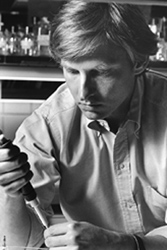 W. Ian Lipkin ’74
W. Ian Lipkin ’74
(professor of epidemiology, neurology, and pathology: Columbia University; Principal investigator and scientific director: Northeast Biodefense Center)
An internationally recognized expert in pathogen discovery, Ian Lipkin researches diseases of the central nervous system. He led the team that used unique molecular methods to identify the West Nile Virus as the cause of the encephalitis outbreak in New York State in 1999. Lipkin is also a pioneer in AIDS research. More recently, as a result of his work advising the Chinese government on dealing with the severe acute respiratory syndrome (SARS), he was asked to help run the first infectious disease center in China. “Sarah Lawrence gave me something critical to success in the long term: the confidence and the ability to think independently; to exploit serendipity; to be the ‘abnormal’ scientist who invents radical new theories.”
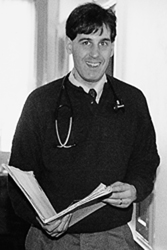 Andrew Schamess ’86
Andrew Schamess ’86
(former medical director: La Clinica del Pueblo, Washington, DC; private practice, Pittsfield, MA)
Andrew Schamess began questioning the roots of America’s medical system while he was an undergraduate. He did an internship at a homeless shelter for women in New York City’s Times Square and won a federal grant to study concepts of mental health in early American literature. He was drawn to medical school by a question that deeply distressed him: Why do people in the most need get the least help from doctors and hospitals? When he began his internship in internal medicine at George Washington University, he volunteered at La Clinica del Pueblo, a free community clinic in Washington, DC, that treats uninsured immigrants from Central and South America. As its medical director, he started specialized clinics for diabetes and reproductive health; he was also a professor at Howard University. “People tend to be sicker in the uninsured population. All of a sudden, you begin to realize why you’re in medicine—you could save a life.”
Judith Benkendorf MS ’80
project manager: American College of Medical Genetics; senior genetic counselor and professor: University of Maryland School of Medicine
Eugenia George ’65
physician; member: American Journal of Tropical Medicine and Hygiene
Deborah Loeff ’72
chief of pediatric surgery: Midwest Pediatric Surgery
Donald Miller ’75
physician: Merrimack Family Medicine, Tewksbury, MA
John Werber ’80
chief of dermatology: Spellman Center for HIV-related diseases, St. Clare’s Hospital, New York City
Scholarship & Teaching
Inspired by their own experience at Sarah Lawrence, a large number of graduates are drawn to scholarship and teaching at all levels, from early childhood to college. Nearly 70 percent of alumnae/i earn master’s degrees, and some 25 percent receive doctorates.
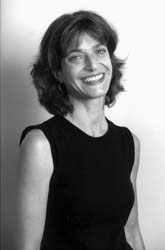 Karen Adolph ’86
Karen Adolph ’86
(professor, neural science, psychology: New York University)
“My aim,” says Karen Adolph of her teaching, “is to capture students’ interest by structuring course work around issues that they already find compelling.” That philosophy of teaching, she notes, she first learned at Sarah Lawrence. “I loved the way I was taught at Sarah Lawrence, so I try to do that wherever I can.” At Sarah Lawrence’s Early Childhood Center, she says, “We were taught that every baby who came in was the most special child and that our job was to foster their independence—and we were facilitators. I teach those concepts to my students now.” A recipient of a 2003 Distinguished Teaching Award from NYU, Adolph clearly values her students. Other awards Adolph has received include a 2006 Merit Award from the National Institutes of Child Health and Human Development, and the 2002 Robert L. Fantz Memorial Award of the American Psychological Foundation, among others. Adolph encourages students to visit her office. “At Sarah Lawrence,” she says, “we were used to talking with our professors—we even called them by their first names.”
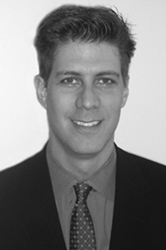 Robert Rhodes ’90
Robert Rhodes ’90
(principal: Millennium High School)
Robert Rhodes isn’t just the principal of Millennium High School in lower Manhattan. He also designed its academic program, based on progressive techniques he first experienced at Sarah Lawrence. After graduation, Rhodes taught at an alternative high school for at-risk youth in Queens, then at Manhattan’s School of the Future, where he became the assistant principal. “I enjoy helping young people develop their passion for learning and teaching them to pursue their own ideas,” he says. At Sarah Lawrence, he focused on social science, with a sprinkling of science and math. He loved the close relationships between students and teachers, and has implemented a system akin to donning at his own school. “It’s so powerful to have an idea, and then meet with someone who cares deeply about the subject and talk it over,” he says.
Teodolinda Barolini ’72
Lorenzi Da Ponte Professor of Italian, chair of the Italian Dept.: Columbia University; fellow: American Academy of Arts and Sciences, American Philosophical Society, Medieval Academy of America; former president: Dante Society of America
Amanda Foreman ’91
writer, historian: Georgiana, Duchess of Devonshire (Modern Library)—basis of the 2008 film Duchess— Our American Cousins: The British Volunteers in the Civil War (Random House); winner: 1998 Whitbread Prize, Biography of the Year
Merle Goldman ’53
professor emerita of history: Boston University; member: United Nations Commission on Human Rights; foreign policy consultant; author: Sowing the Seeds of Democracy in China (Harvard University Press), among others
Cecelia Lopez ’85
preschool teacher, translator: Bogotá, Colombia
Suzanne Rudolph ’51
political science professor: University of Chicago; co-author: In Search of Lakshmi (University of Chicago Press)
Joan B. Waite ’55
co-founder, past Director: African American Educational Center of Northern New Jersey; mezzo soprano; past faculty member: Sarah Lawrence College
Writing, Publishing & Journalism
The basis of a Sarah Lawrence education is communication—written and verbal—about ideas, opinions, and shades of meaning. And the College’s renowned writing program is one of the strongest in the country. It’s no wonder so many Sarah Lawrence graduates pursue careers in which they form ideas, stories, and images—or manage others who do.
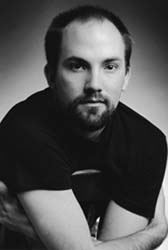 Clay McLeod Chapman ’00
Clay McLeod Chapman ’00
(novelist, playwright)
“It wasn’t difficult to bridge the gap between Sarah Lawrence and the professional world,” says Clay McLeod Chapman. “It happened all at once. The city was there already—part of my college experience.” That experience included a theatre internship at Performance Space 122, where Chapman performed monologues he had written. Shortly before he graduated, a literary agent happened to see him in a show. “She wanted to read more. Three weeks later, she called me to a meeting with Disney’s Hyperion Books. A week later I had signed a two-book contract.” Since then, he has produced the goods: Rest Area (Hyperion, 2002), a collection of stories, and Miss Corpus (Hyperion, 2003), a novel. He has also continued to perform his work in Manhattan and elsewhere with a theatre troupe that calls itself the Pumpkin Pie Show. “We’re an artistic hodgepodge of music, theatre, and literature. The literary component is basically me.” To Chapman, that combination seems a natural outgrowth of his education. “Sarah Lawrence gave me a finer understanding of writing—helped me see it as a medium that could stretch across many forms.”
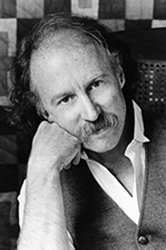 Allan Gurganus ’72
Allan Gurganus ’72
(writer)
Though best known for his novel Oldest Living Confederate Widow Tells All (Knopf, 1989), Allan Gurganus also writes short stories, editorial essays, and film scripts. In the title novella of Gurganus’s collection The Practical Heart, a narrator tells the story of how his great-aunt, a poor Scottish immigrant, came to have her portrait painted by John Singer Sargent. “I’m still amazed that I can make a living by writing, getting paid to explore,” Gurganus says. His versatility and enthusiasm are traits he claims Sarah Lawrence fostered. During his first year, he studied writing, film history, Shakespeare, and choreography.
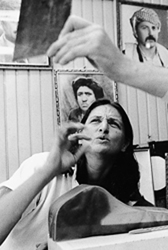 Susan Meiselas ’70
Susan Meiselas ’70
(photojournalist)
Susan Meiselas spent many years in the Kurdish area of northern Iraq where she first worked with Human Rights Watch in 1988 and 1989, documenting the destroyed villages and mass graves of Saddam Hussein’s Anfal campaign, an attempt to exterminate the Kurdish people. She has traveled in Europe, the Middle East, and the United States to compile a photo history of the Kurds that spans more than 100 years. Funded in part by a MacArthur Foundation Fellowship, the work resulted in a book, Kurdistan: In the Shadow of History (Random House, 1997), as well as an exhibit at the Menil Collection in Houston. She is also well known for her work documenting human rights abuses in Latin America. At Sarah Lawrence, Meiselas took an anthropology course about peasant societies, which she recalls “had to do with observation and connection with other cultures and the world,” and spent her junior year in an international honors program traveling with a group of students and professors through seven countries in various stages of development.
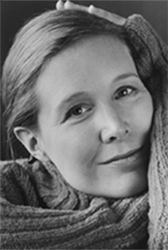 Ann Patchett ’85
Ann Patchett ’85
(writer)
Before Ann Patchett graduated from Sarah Lawrence—where she studied with Allan Gurganus, Russell Banks, and Grace Paley—she sold her first story to The Paris Review. But her course work wasn’t focused only on what it took to get ahead, she recalls. “As it turned out, it proved to be an excellent foundation for a novelist, but it would have been just as helpful to a linguist, a painter, a mathematician,” says the author of Bel Canto, which won the PEN/Faulkner Award and England’s Orange Prize, and was a finalist for the National Book Critics Circle Award.
“The education at Sarah Lawrence was not so much a matter of filling our heads up with facts, but more of learning how to be able to go out and find facts yourself,” explains Patchett, “And it was about teaching us how to be curious.” Patchett’s novels, Run, Bel Canto, The Patron Saint of Liars, Taft The Magician’s Assistant, brought her recognition, honors, and awards. In 2004, Truth & Beauty, her first work of nonfiction, was published. Winner of the Chicago Tribune’s 2004 Heartland Prize for Nonfiction, it is the story of Patchett’s friendship with the late Lucy Grealy ’85, author of the memoir Autobiography of a Face, whom Patchett met at Sarah Lawrence. Another work of nonfiction, What now?, was based on her 2006 commencement address at Sarah Lawrence . She has also written for The New York Times Magazine, The Washington Post, Gourmet, O (the Oprah Magazine), and Vogue. “Sarah Lawrence taught me to desire knowledge, to seek it out not because it would be covered later on a test, but to seek it out because I knew it was something I had to have. It was the kind of education that made you hungry to know everything.”
 Alice Walker ’65
Alice Walker ’65
(writer)
Alice Walker signed her first book contract before graduating from college. “It was at the College that I wrote my first published short story and my first book, there that I learned to feel that what I thought had some meaning.” “At Sarah Lawrence, I found all that I was looking for at the time—freedom to come and go, to read leisurely, to go my own way, dress my own way, and conduct my personal life as I saw fit.” Since then, the social activist, novelist, and poet has published numerous books, including Now is the Time to Open Your Heart (Random House, 2004), By the Light of My Father’s Smile (Random House, 1998), and The Color Purple (Harcourt Brace, 1982), which won the Pulitzer Prize for literature and was made into a 1985 film by Steven Spielberg as well as a 2005 Broadway musical play. In The Same River Twice: Honoring the Difficult (Scribner, 1996), she describes the personal challenges and controversies around the making of the film of The Color Purple.
Brooks Adams ’75
co-writer: Young Americans 2: New American Art at the Saatchi Gallery (Saatchi Gallery); critic; contributing editor: Art in America
Patricia Bosworth ’55
biographer: Marlon Brando and Montgomery Clift; her biography of photographer Diane Arbus has been made into a film, Fur, starring Nicole Kidman and Jane Alexander ’61
Susan Shapiro-Barash '76
author of 13 nonfiction women's issues books including The Nine Phases of Marriage, Toxic Friends, and Little White Lies, Deep Dark Secrets
Denise Duhamel MFA ’87
poet: Two and Two (Pitt Poetry Series) and Mille et un Sentiments (Firewheel Edition) among others; co-editor: Sweet Jesus (Small Press Distribution); winner: National Endowment for the Arts Poetry Fellowship (2001)
Jonathan Fast ’70
novelist: The Jade Stalk (Penguin USA), Golden Fire: An Ancient Novel of India (Arbor House), among others
Jean Feiwel ’79
senior vice president and publisher: Holtzbrinck Publishers; past editor-in-chief and publisher of Scholastic Books, responsible for launching the Harry Potter, I Spy, and Adventures of Captain Underpants books
Karl Taro Greenfeld ’88
editor: TIME Asia; winner: Henry Crown Fellowship, Aspen Institute, 2004
A.M. Homes ’85
novelist: This Book Will Save Your Life (Viking Adult), The End of Alice (Scribner), The Mistress’s Daughter (Viking), among others; contributing editor: Vanity Fair, Mirabella, Bomb, and Blind Spot; winner: Guggenheim Foundation Fellowship (1988), among others
Kate Klimo ’72
vice president and editor-in-chief: Random House Books for Young Readers
Joan Konner ’51
dean and professor emerita: Columbia University Graduate School of Journalism; former producer: NBC News and WNET-New York’s Bill Moyers Journal; winner of 16 Emmy awards
David Lindsay-Abaire ’92
playwright: Fuddy Meers, Rabbit Hole (winner, 2007 Pulitzer Prize), Kimberly Akimbo, among others; winner: the Kesselring Prize (2001), the L.A. Drama Critics Circle Award (2002), among others
Catherine McKinley ’89
memoirist: The Book of Sarahs (Counterpoint); editor: Afrekete: An Anthology of Black Lesbian Writing (Anchor Books/Doubleday); associate director: The Publishing Certificate Program, City University of New York; 1999 Fulbright Grant recipient, Ghana, West Africa
April Reynolds Mosolino ’97
novelist: Knee Deep in Wonder (Metropolitan); winner: Zora Neale Hurston/Richard Wright Foundation Award for work-in-progress, a PEN/American Open Book: Beyond Margins Award (2004), among others
Esmeralda Santiago MFA ’92
author, memoirist: When I Was Puerto Rican (Vintage), Almost a Woman (Vintage), The Turkish Lover (Da Capo), among others; co-editor: Las Mamis (Vintage), Las Christmas (Vintage); winner: the Alex Award from the American Library Association (1999), among others
Julie Shigekuni MFA ’90
novelist: A Bridge Between Us (Doubleday), Invisible Gardens (St. Martin’s), among others; literary anthologies: On a Bed of Rice: An Asian American Erotic Feast (Anchor Books/Doubleday), among others; editor: Blue Mesa Review; winner: Henfield Award and an American Japanese National Literary Award
Ingrid Sischy ’73
international editor: European Vanity Fair; former editor-in-chief: Interview Magazine; contributing editor: Vanity Fair
Barbara Walters
former co-anchor: ABC’s 20/20 and The Barbara Walters Specials; co-host/co-executive producer: The View